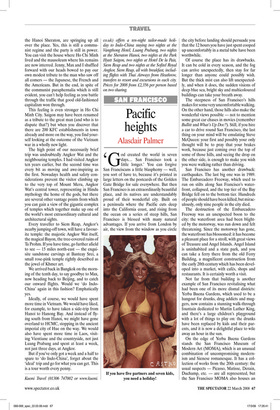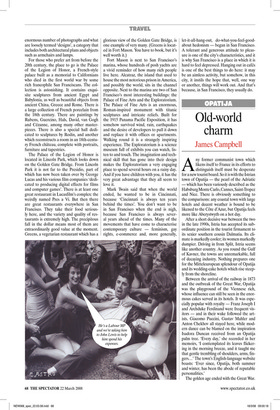Pacific heights
Alasdair Palmer
‘God created the world in seven days... San Francisco took a little longer.’ You can forgive San Franciscans a little blasphemy — well, you sort of have to, because it’s printed in large letters on the postcards of the Golden Gate Bridge for sale everywhere. But then San Francisco is an extraordinarily beautiful place, and its natives are understandably proud of their wonderful city. Built on a peninsula where the Pacific cuts deep into the California coast, and rising from the ocean on a series of steep hills, San Francisco is blessed with many natural advantages. If you arrive from London by air, the view from the window as you circle the city before landing should persuade you that the 12 hours you have just spent cooped up uncomfortably in a metal tube have been worthwhile.
Of course the place has its drawbacks. It can be cold in every season, and the fog can arrive unexpectedly, then stay for far longer than anyone could possibly wish. But the thick mist can also lift unexpectedly, and when it does, the sudden visions of deep blue sea, bright sky and multicoloured buildings can take your breath away.
The steepness of San Francisco’s hills makes for some very uncomfortable walking. On the other hand, those hills also make the wonderful views possible — not to mention some great car chases in movies (remember Bullitt and What’s Up Doc?). Still, if you hire a car to drive round San Francisco, the last thing on your mind will be emulating Steve McQueen: your first and possibly your only thought will be to pray that your brakes work, because just coming over the top of some of those hills, and seeing the drop on the other side, is enough to make you wish you were walking rather than driving.
San Francisco has another drawback: earthquakes. The last big one was in 1989. The Embarcadero Freeway, which used to run on stilts along San Francisco’s waterfront, collapsed, and the top tier of the Bay Bridge fell on to the bottom tier. Hundreds of people should have been killed, but miraculously, only nine people in the city died.
The destruction of the Embarcadero Freeway was an unexpected boon to the city: the waterfront area had been blighted by the motorway, was run down and felt threatening. Since the motorway has gone, the waterfront has blossomed: it has become a pleasant place for a stroll, with great views of Treasure and Angel Islands. Angel Island is uninhabited and a state park, and you can take a ferry there from the old Ferry Building, a magnificent construction from the early 20th century which has been developed into a market, with cafés, shops and restaurants. It is certainly worth a visit.
Not far from that building is another example of San Francisco revitalising what had been one of its more dismal districts: Yerba Buena Gardens, which used to be a hangout for drunks, drug addicts and muggers, now contains a stunning walk-through fountain dedicated to Martin Luther King, and there’s a large children’s playground with a lot of things to play on: the drunks have been replaced by kids and their parents, and it is now a delightful place to wile away an hour in the sun.
On the edge of Yerba Buena Gardens stands the San Francisco Museum of Modern Art (MOMA), which is an unusual combination of uncompromising modernism and Sienese romanesque. It has a collection of works from the 20th century: the usual suspects — Picasso, Matisse, Derain, Duchamp, etc. — are all represented, but the San Francisco MOMA also houses an enormous number of photographs and what are loosely termed ‘designs’, a category that includes both architectural plans and objects such as armchairs and lamps.
For those who prefer art from before the 20th century, the place to go is the Palace of the Legion of Honor, a French-style palace built as a memorial to Californians who died in the first world war by some rich francophile San Franciscans. The collection is astonishing. It contains exquisite sculptures from ancient Egypt and Babylonia, as well as beautiful objects from ancient China, Greece and Rome. There is a large collection of French porcelain from the 18th century. There are paintings by Rubens, Guercino, Hals, David, van Gogh and Cézanne, among many other masterpieces. There is also a special hall dedicated to sculptures by Rodin, and another which reconstructs a room in an 18th-century French château, complete with portraits, furniture and tapestries.
The Palace of the Legion of Honor is located in Lincoln Park, which looks down on the Golden Gate Bridge. From Lincoln Park it is not far to the Presidio, part of which has now been taken over by George Lucas and his various film companies ‘dedicated to producing digital effects for films and computer games’. There is at least one great restaurant in Lucasfilm’s complex: the weirdly named Pres a Vi. But then there are great restaurants everywhere in San Francisco. They take their food seriously here, and the variety and quality of restaurants is extremely high. The precipitous fall in the dollar means most of them are extraordinarily good value at the moment. Greens, a vegetarian restaurant which has a glorious view of the Golden Gate Bridge, is one example of very many. (Greens is located in Fort Mason. You have to book, but it’s well worth it.) Fort Mason is next to San Francisco’s marina, whose hundreds of posh yachts are a vivid reminder of how many rich people live here. Alcatraz, the island that used to house the most notorious prison in America, and possibly the world, sits in the channel opposite. Next to the marina are two of San Francisco’s most interesting buildings: the Palace of Fine Arts and the Exploratorium. The Palace of Fine Arts is an enormous, Roman-inspired monument with titanic sculptures and intricate reliefs. Built for the 1915 Panama Pacific Exposition, it has somehow survived wind, rain, earthquakes and the desire of developers to pull it down and replace it with offices or apartments. Walking round it is a strangely inspiring experience. The Exploratorium is a science museum full of exhibits you can watch, listen to and touch. The imagination and technical skill that has gone into their design makes the Exploratorium a very engaging place to spend several hours on a rainy day. And if you have children with you, it has the very great advantage that they all seem to love it.
Mark Twain said that when the world ended, he wanted to be in Cincinnati, because ‘Cincinnati is always ten years behind the times’. You don’t want to be in San Francisco when the end is nigh, because San Francisco is always several years ahead of the times. Many of the movements that have come to characterise contemporary culture — feminism, gay rights, e-commerce and, more generally, let-it-all-hang-out, do-what-you-feel-goodabout hedonism — began in San Francisco. A tolerant and generous attitude to pleasure is one of the city’s characteristics, and it is why San Francisco is a place in which it is hard to feel depressed. Hanging out in cafés is one of the best things to do here: it may be an aimless activity, but somehow, in this city, it instils the hope that, well, one way or another, things will work out. And that’s because, in San Francisco, they usually do.



















































































 Previous page
Previous page